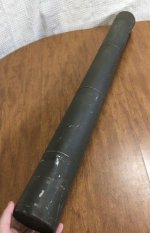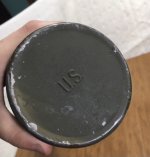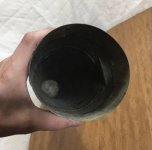So, the micarta ones had wooden bottoms too?
No. Just ignore everything in Random Guy's post. Starting from scratch, here's the information you need:
Tube - a little over 24" long, about 3" wide. Go with
@sirhrmechanic's advice and just get tubing in the correct dimensions. Add a piece of the same material to the bottom and find/make a funnel shaped cap for the lid. Get fancy with a spring at the bottom or just add foam or whatever padding to need to get a secure fit for the scope on the inside. Done. No wood or aluminum or other shit, keep it simple.
Here's a more detailed explanation with photos (actual first-hand information, not a book):
The tube on the left is micarta, it has a micarta bottom and there's a spring on the inside bottom of the tube. The middle tube is micarta, it has a micarta bottom and that's it, no spring on the inside. The tube on the right is aluminum, it has an aluminum bottom, no spring either (has some pad at the bottom, probably a thin piece of leather).
None of these original WWII era Unertl tubes have wood on them. This is also the only aluminum case known because it sucks. I doubt they made aluminum ones decades later either, because the aluminum case sucks compared to the micatra ones.
Here's a photo of the inside of the micarta tube with a spring at the bottom. Notice how the piece on top of the spring is funnel shaped, this is to center the scope in the tube. The piece on the bottom also has a thin layer of padding to help protect the scope. The spring served 2 functions, the first is to dampen any shock to the scope if the tube gets knocked around. The second it to push the scope up against the the tube's cap, which is also funnel shaped to center the scope in the tube. All this scope centering sorta prevented the scope's turrets from impacting the case wall (preventing damage, losing zero, preventing noise, whatever reasons).
Here's the inside of the cap, notice the circular marks in the micatra from the scope being wedged into it from spring tension. The cap is shaped like this so that the scope self centers and doesn't rattle around in the tube. To say that the cap has a pointed top in order to "shed rainwater" is retarded, I have no idea why Poyer wrote that.
Here's the inside of the micarta tube that doesn't have the spring at the bottom. I have no idea if this is a completely different style of case, if it's earlier than the spring loaded ones or if it used to have a spring but was somehow damaged. Personally, I really don't care. All I know is that this is the case you should copy if you want to make an easy version of the Unertl tube. It's a flat bottom, put some padding down there to get your scope up to the cap and be done with it. If you're awesome at making shit, then try doing the spring loaded case.

Attaching the cap to the tube is pretty basic, 3 rivets on the tube line up with 3 "T" shaped cuts in the cap. To close, line the cutouts with the rivets, push down and rotate either left or right (it doesn't matter, it's "T" shaped). To open, rotate the cap slowly while lightly lifting, you'll soon rotate to the release cut and the cap pops off. There's not snap closure, it's a few rivets and cuts. If you're able to do it this way on your build, go for it. If it doesn't matter to you, then choose an option that's easier to make.
If there's a spring in the bottom of the case, the scope will extend out of the tube. When you put the cap on, it pushes the scope down and the spring tension holds it in place. If it doesn't have a spring, the scope will drop in and rattle around in every direction. If you're not using a spring, I'd recommend some padding on the bottom of the tube and inside the cap to hold the scope steady.
And some half-assed measurements:


















